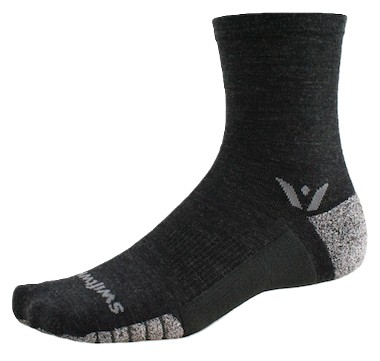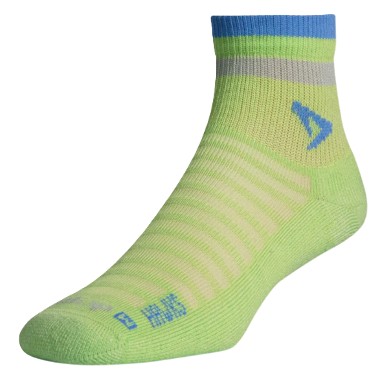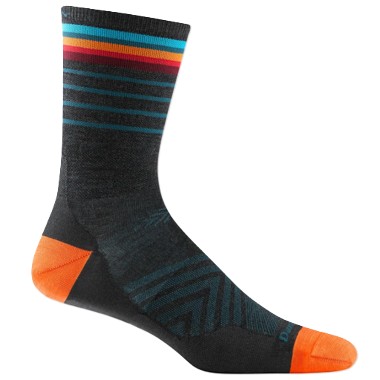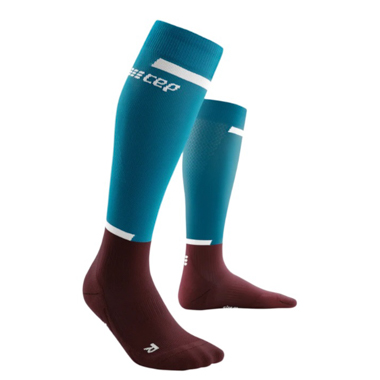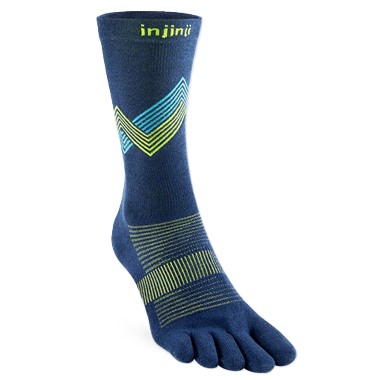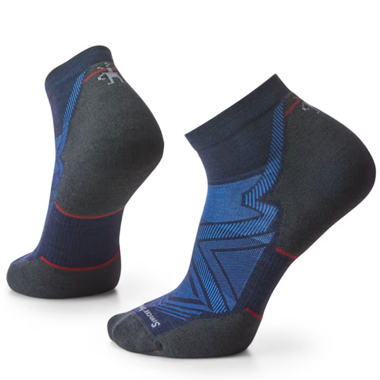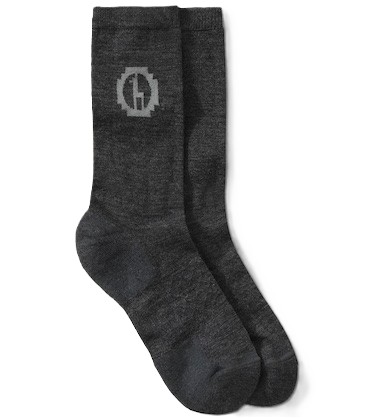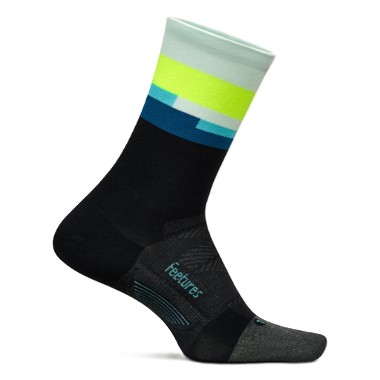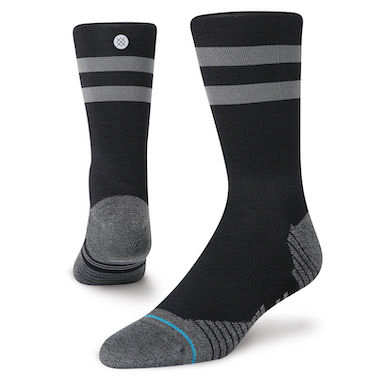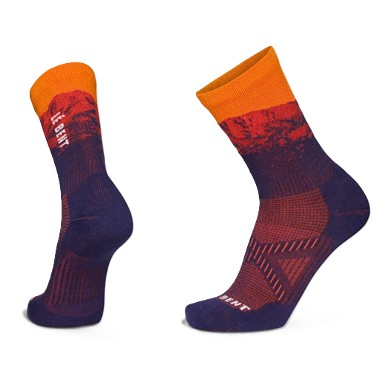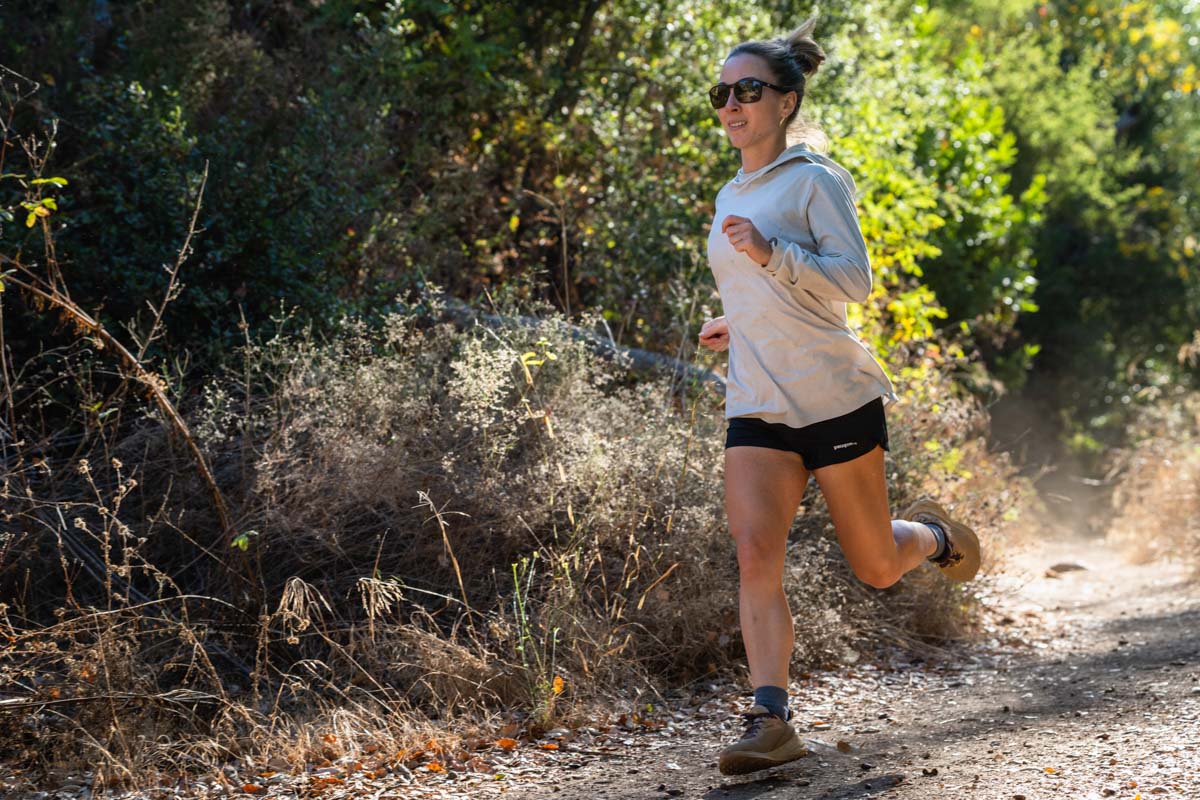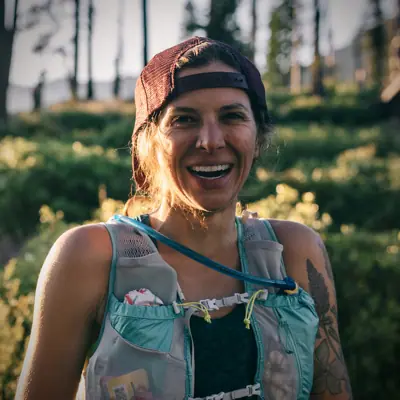
The right socks can keep your feet happy during your run, and there are endless options to choose from. Photo: iRunFar/Eszter Horanyi
Socks are arguably one of the most important pieces of running gear, and choosing the best running socks for your unique needs is worth thoughtful consideration and a bit of investment. Well-constructed, tailored running socks are generally more expensive than cheaply woven silhouettes — for good reason.
The best running socks feature a scientific curation of fibers for moisture management, heat transfer, placement and depth of cushion, and height. Many are designed for specific conditions: toasty canyons, winter storms, steep and rocky trails, or dusty singletrack. A better-made sock also survives more miles through the wilderness than a bargain option.
To create this guide, our squad of professional, competitive, collegiate, and recreational trail runners and ultrarunners pulled on a range of hosiery for hundreds and hundreds of miles. From dusk to dawn, we ran across the Rocky Mountains, through the Cascade Mountains, all over the Western United States, and throughout New Zealand through gloppy mud, sunbaked singletrack, snow, and rain.
At the top of our list of socks is the Swiftwick Flite XT Trail Mid-Crew, which has an excellent fit and wicks away moisture quickly and efficiently. We loved the Drymax Extra Protection Hot Weather Running ¼ Crew Socks for running in hot weather, while the Darn Tough Stride Micro Crew Ultra-Lightweight Running Sock was our favorite wool-blend sock.
Also, learn more about our testing methodology, read our advice for choosing your next running socks, and see our frequently asked questions about running socks at the bottom of this guide. And if compression socks are your thing, check out our Best Compression Socks buyer’s guide.
Best Running Socks of 2024
- Best Overall Running Socks: Swiftwick Flite XT Trail Mid-Crew
- Best Running Socks for Hot Weather: Drymax Extra Protection Hot Weather Running ¼ Crew Socks
- Best Running Socks for Cold Weather: Swiftwick Pursuit Quarter Crew High
- Best Wool Running Socks: Darn Tough Stride Micro Crew Ultra-Lightweight Running Sock
- Best Compression Socks: CEP The Run Compression Tall Socks 4.0
- Best Toe Socks: Injinji Run Lightweight Crew
- Best of the Rest Running Socks: Smartwool Run Ankle Socks, Paka Essential Crew Socks, Feetures Elite Ultra Light Mini Crew, Stance Ultralight Performance Crew Socks, Lé Bent Zero Cushion 3/4 Crew Trail Sock

iRunFar’s Meghan Hicks tests a pair of Injinji crew socks during an early-season outing in the San Juan Mountains in Colorado. Photo: iRunFar/Eszter Horanyi
Best Overall Running Socks: Swiftwick Flite XT Trail Mid-Crew ($27)
- Snug and secure
- Manages moisture super well and dries fast
- The moderate cushion is not too thick or too thin
Cons:
- Higher cost
The Swiftwick Flite XT Trail Mid-Crew is a snug-fitting running sock with a soft feel, excellent breathability, and thumbs-up ankle protection. Designed for hiking and trail running, they incorporate materials and a knit design to wick moisture, prevent blisters, and provide extra support on uneven terrain. Swiftwick achieves this with a blend of merino wool and olefin fibers, which have natural wicking properties, and nylon, polyester, and spandex, which are breathable and quick-drying. The material is light and slightly compressive.
This sock has moderate cushioning beneath the arch and heel, which we found provides adequate protection mile after mile, especially on rocky descents. The fabric below the forefoot and heel has alternating rows of cushion that feature a proprietary grippy fiber to reduce friction and prevent bunching that can result in blisters. Pairing them with long, full-length underwear also makes them a good option for ski touring.
This cushion design works with the merino and olefin blend in the footbed to wick moisture and keep feet dry. The top of the sock is a slightly thinner mesh that increases its overall breathability, and the snug compression around the arch and ankle feels like a nice, firm hug. While these socks do not have significant compression, they provide enough of a squeeze to feel supportive. They are also tight enough to count on them not to move around on your foot without feeling constrictive.
Although many trail runners love this sock’s extra height and ankle protection, this line of socks offers other options. A Swiftwick Flite XT Trail Quarter Crew hits just above the ankle bone. Finally, Swiftwick’s non-trail version of this sock, the Flite XT, has also been a longtime favorite among iRunFar testers and is available in No-Show, Ankle, and Mid-Crew options.
Material: 38% nylon, 24% merino wool, 22% olefin, 13% polyester, 3% spandex
Shop the Swiftwick Flight XT Trail Mid-CrewBest Running Socks for Hot Weather: Drymax Extra Protection Hot Weather Running 1/4 Crew Socks ($28)
- Lightweight
- Excellent ventilation
- Tenacious, long-lasting fabric
Cons:
- It looks thick and cumbersome
- Pricier
The Drymax Extra Protection Hot Weather Running 1/4 Crew Socks are lightweight, very breathable, and resist heat buildup during hot, sun-exposed runs and races. The upper side of the sock features a mesh weave that dumps heat. A consistent layer of moderate padding stretches along the bottom of the foot, from heel to toe, beneath the metatarsals, which provides excellent protection and comfort.
The fabric blend includes a Teflon fiber — polytetrafluoroethylene (PTFE) — which, according to the Polymer Properties Database, is among the best synthetic materials for minimizing friction. The PTFE is located in the heel, forefoot, and toe areas, making them super durable. While we generally shy away from products that contain these types of perfluoro compounds whenever possible, we think they make a big difference in comfort in these socks.
One professional mountain runner and product tester has used a pair of these socks for three years and notes no visible wear and tear. He added, “The slim fit works well with snugger-fitting shoes,” and the lower quarter-crew length sits an inch above the ankle, which is generally preferable for toasty jaunts. The fiber blend also includes olefin, which wicks moisture and sweat.
After pounding countless miles in these socks, we experienced no blisters, slippage, or lingering odors. The interior of the toebox was smooth and went unnoticed. The only downside to these socks is that they aren’t very soft, and testers sometimes describe them as coarse to the touch.
Material: 36% Drymax olefin, 26% polytetrafluoroethylene (PTFE), 22% polyester, 12% spandex, 4% nylon
Shop the Drymax Extra Protection Hot Weather Running Crew 1/4 SocksBest Running Socks for Cold Weather: Swiftwick Pursuit Quarter Crew High ($20)
- Soft, fuzzy, and cozy interior
- Wool has natural temperature-regulating properties
- The cuff feels snug and secure
Cons:
- A slightly thicker design is too warm on the hottest days
The Swiftwick Pursuit Quarter Crew High is a moderately cushioned sock you can wear year-round, but we especially love it for colder weather. It is mostly merino wool, with nylon and spandex added for more softness, stretch, durability, and compression. The inside of the sock feels fuzzy and soft, ideal for those brisk shoulder-season runs. At the same time, it hugs the foot enough to not feel bulky or bunchy.
Merino wool is a natural fiber known for its temperature-regulating properties. It provides warmth in cold conditions, cooling in hot weather, and wicks moisture well regardless of the temperature. The downside of wool is that it can feel scratchy or coarse compared to synthetic fibers, and we found this sock incredibly comfortable.
Wool is also typically less durable than synthetics, though wool blended with nylon, polyester, spandex, or other materials is comparable. This sock has wool wrapped around a blend of nylon and spandex, and the material gently squeezes the foot, providing slight compression around the midfoot and cuff. This design and a seamless toebox help keep the sock in place, reducing the likelihood of developing blisters.
While this sock can perform throughout all seasons, its moderate cushioning and cozy, fuzzy feel may make it too warm for runners during the summer heat. This is especially true if you prefer thin socks under a more snug-fitting shoe. This line of socks comes in a variety of height ranges that will suit nearly any need.
Material: 63% merino wool, 35% nylon, 2% spandex
Shop the Swiftwick Pursuit Quarter Crew HighBest Wool Running Socks: Darn Tough Stride Micro Crew Ultra-Lightweight Running Sock ($21)
- Lifetime guarantee
- 100% Responsible Wool Standard-certified materials
Cons:
- There is no extra cushioning on the sole
For our testing team members who self-identify as wool snobs, the Darn Tough Stride Micro Crew Ultra-Lightweight Running Sock is a favorite for many reasons. We found them incredibly comfortable, and we love that Darn Tough guarantees these socks for life. If you wear holes in them, you can send them back, and they’ll send you a new pair.
These merino-blend socks are 55% nylon, 38% merino wool, and 7% Lycra, making them durable and stretchy while taking advantage of wool’s moisture-wicking and odor-resistant properties. Many runners gravitate toward wool socks because they tend not to pick up smells, and fastpackers, who will wear the same socks multiple days in a row, love the material.
Several cooling panels around the sock increase its breathability and allow it to dry quickly. Made of thin fibers, this sock doesn’t feel bulky and lives up to its ultra-lightweight name. The crew length reaches about six inches above the top of a shoe, providing plenty of protection from any trailside brush or rocks.
The socks provide extra support under the arch, which also helps prevent bunching during long runs. However, there’s no extra padding on the sole, which might be an issue for people looking for more cushion from their socks. The minimal amount of material keeps the socks from slipping around and provides a skintight feel, which helps prevent blisters and other skin irritation.
Darn Tough is a privately owned company that makes all its socks in Vermont using 100% Responsible Wool Standard-certified wool, so you can feel good about wearing them. Plus, they look good and come in a few different color schemes. You can also find this sock in our Best Wool Running Apparel guide.
Material: 5% nylon, 38% merino wool, and 7% Lycra
Shop the Men's Darn Tough Stride Micro Crew Ultra-Lightweight Running SocksShop the Women's Darn Tough Stride Micro Crew Ultra-Lightweight Running Socks
Best Compression Socks: CEP The Run Compression Tall Socks 4.0 ($60)
- Advanced fabrics from a company known for its compression gear
- Multiple color combinations are available
- Breathable materials
Cons:
- Expensive
- May be too tall for shorter runners
If you’re looking for a pair of compression socks that you can wear for both running and recovery, the CEP The Run Compression Tall Socks 4.0 are a great option from a brand known for making high-quality compression clothing. CEP makes an extensive line of compression gear, and they know how to make apparel that works for running.
These socks have a lightweight material and extra mesh-like panels in key spots to improve their overall breathability. The brand uses its Smart Dry Extreme Air Technology in these socks, allowing them to keep you cool in the heat and warm when it gets cold.
According to CEP, the thermoregulating fabric technology is activated by rising body temperature and cools the skin, and the material is treated with silver to help with odor control. We tested these socks in New England’s humidity and found them quite breathable compared to other knee-high compression socks we tested.
These socks feature graduated 20 to 30 millimeters of mercury (mmHg) compression at the ankle with targeted areas in the arch and ankle for increased support. We thought the compression around the calf was more than some of the other socks we tested, but it never felt constrictive. The footbed padding wasn’t bulky but still provided a bit of extra cushion.
These socks are quite tall, so they may hit a bit higher on shorter runners than preferred. On our five-foot-three-inch tester, the top of the sock band reached behind the knee rather than just below.
Our Best Compression Socks guide explains more about the benefits of compression socks for running and recovery and offers more options.
Material: 83% polyamide, 17% elastane
Shop the Men's CEP The Run Compression Tall Socks 4.0Shop the Women's CEP The Run Compression Tall Socks 4.0
Best Toe Socks: Injinji Run Lightweight Crew ($16)
- Minimizes blisters between the toes
- Great cushion and breathability
- Solid moisture transfer
- Excellent coverage and protection
- Great value
Cons:
- Toe socks aren’t for everyone
- Short and tiny or high-volume toes are the least compatible with these socks
If you haven’t tried toe socks — and many on the iRunFar team recommend you do — the Injinji Run Lightweight Crew is worth a closer look. One of our gear editors turned her nose up at toe socks for years until a pair finally worked their way into her life, and now she’s wondering what took her so long to become a convert. If you’ve already discovered toe socks, there’s a solid chance you have a drawer full of these or some variation of them. For some runners, toe socks are the answer to staying comfortable and blister-free on their longest ventures and daily miles.
Theoretically, fabric wrapped around each toe keeps digits from brushing against each other, reducing friction, chafing, and blisters, especially between the toes. The design also helps splay the toes out, encouraging them to engage while running. That said, if you’re running in shoes with a narrow toebox, toe socks may actually take up too much volume and cause chafing on the outside of the big and little toes.
We found this sock protective, comfortable, cushioned, and breathable during testing. It has a super-soft, lightweight fabric around the toes, and its stretchy fit reaches up to mid-calf height, putting it among the tallest of the crew socks in this guide. Since this extra-tall crew height could make the sock more or less appealing depending on the length of your lower leg and personal preferences, it’s worth pointing out that this weight of sock is also available in a mini-crew that hits above the ankle and a no-show version.
In testing, the moisture transfer in these socks was excellent, and they never got drenched with sweat. The fabric didn’t slip and never bunched. By the end of long runs, these socks held onto their elasticity and didn’t smell.
When it comes to toe socks, Injinji’s offerings are widely loved and runner-approved. That said, toe socks like this may take some getting used to, and some runners will feel uncomfortably aware of the fabric between their toes, especially on a sustained, steep, and technical descent. They also require a bit more work to get all the toes turned right-side-out before or after washing. As such, toe socks may not be the right solution for every runner. Nevertheless, they’re a worthy consideration for your sock drawer — and at a very reasonable price for a pair of socks, they’re worth a try if you’re curious.
Material: 63% Nylon, 33% CoolMax, 4% Lycra
Shop the Injinji Run Lightweight Crew socksBest of the Rest Running Socks: Smartwool Run Ankle Socks ($21)
- Sufficient ankle protection
- Stink-resistant and durable wool blend
- Cuff stays put
Cons:
- Not as durable as full synthetic socks
For runners who want a high-quality, no-frills, wool-blend sock without a lot of cushion, fancy tech, or a super tall cuff, the Smartwool Run Ankle Socks are our top recommendation. Although these wool socks are relatively thin, they’re still pretty durable, thanks to a mix of nylon and elastane blended with the merino wool. That said, they probably won’t last as long as a sock made of purely synthetic materials. But, since they’re almost 50% wool, they naturally resist odor-causing bacteria and don’t get as stinky as fully synthetic socks.
Finally, although they have a bit of targeted cushion under the ball of the foot and the heel, these aren’t highly cushioned socks by any stretch. We appreciated this sock for its breathability and lack of bulkiness or wrinkles. The 3.25-inch cuff stays put and provides enough ankle protection on the trail, while the seamless toe design gives toes room to wiggle and helps to prevent chafing.
“I’d say they’re just a super solid pair of durable socks that seem to last for a long time, especially for relatively thin wool,” reported one tester who wore these socks while running and fastpacking all over Colorado and southern Utah. “They don’t bunch up at all and don’t get gross and damp during long days out.”
In addition to being comfortable, breathable, and reliable, these socks are made in the U.S. and are available in a handful of fun patterns and colors. And, if you’re wondering what to do with older Smartwool socks that are taking up space at the bottom of your drawer, Smartwool will take them off your hands — er, feet. Through their Second Cut Project, Smartwool partners with ThredUp to keep lightly used socks from the landfill by reselling them. You can also return your old and worn-out socks to them for recycling. Learn more on their website.
Material: 45% merino wool, 31% nylon*, 21% recycled nylon,3% elastane
*Specific percentage of recycled nylon will vary as Smartwool transitions to 100% recycled nylon
Shop the Smartwool Run Ankle SocksBest of the Rest Running Socks: Paka Essential Crew Socks ($24)
Pros:
- Velvety soft and supple
- Made with sustainable materials
- Good value and a lifetime guarantee
Cons:
- Lacks compression of other socks in this guide
The Paka Essential Crew Socks are supremely soft, comfortable, lightweight, and breathable running socks. Yes, even our feet deserve buttery smooth apparel, and this sock wraps our feet in silky soft alpaca wool while providing all the performance we need in a running sock. These socks are also available in an ankle version, which is equally soft and stretchy and a favorite at iRunFar.
These socks are made in Peru using a blend of alpaca wool, Tencel, which is a fiber derived from eucalyptus wood pulp, nylon, and spandex. Both alpaca wool and nylon are soft, lightweight fibers, so this medium-cushion sock feels very smooth and light.
Likewise, Tencel, a brand name for lyocell fibers, is known for its super-soft feel and sustainability since it usually comes from sustainably harvested trees and produces less toxic waste in manufacturing than other synthetics. It’s also worth pointing out that Paka is a certified B-Corporation, which means it has met high standards for supply chain practices and the materials it uses.
These socks are constructed with thinner knit paneling around the midfoot and above the toes, with slightly thicker cushioning beneath the ball of the foot, around the heel, and behind the ankle. Like sheep, alpaca wool has natural temperature-regulating properties, keeping you warm in cold temperatures and wicking sweat on hotter days. It also dries quickly and resists odor-causing bacteria.
By blending alpaca wool with nylon and spandex, Paka can increase the durability and stretchiness of these socks. On that note, while these socks fit comfortably against the foot, they don’t provide any compression, and they’re among the stretchiest socks in this guide. In fact, we noticed our feet sliding around a bit inside these socks when we wore them without shoes. That said, we did not experience any bunching or hot spots once we put shoes on and took to the trails.
Material: 41% alpaca fiber, 8% Tencel, 50% recycled nylon, 1% spandex
Shop the Paka Essential Crew SocksBest of the Rest Running Socks: Feetures Elite Ultra Light Mini Crew ($20)
- Outstanding balance of light cushion and moderate compression
- Snug, no-budge fit
Cons:
- Solid sock, but not a standout in any one area
The Feetures Elite Ultra Light Mini Crew is another great crew sock ideal for the trails. It has light cushioning with targeted compression around the arch and maintains a snug fit that doesn’t create hot spots. It also has an anatomical design with a dedicated left and right sock. Like the top picks in this guide, this sock hugs the foot comfortably, wicks sweat, and dries quickly. It doesn’t slip or bunch, and its crew height protects from rocks, mud, dust, and brush on the trail.
This sock is lightweight and breathable, thanks to thin mesh panels across the top. Its footbed, toebox, and cuff have slightly more cushioning and support than other parts of the sock. The arch has some ribbing for targeted compression, and the heel cup cradles the heel to provide a secure, supportive fit.
The toebox is slightly more roomy than other socks in this guide, giving the toes enough space to wiggle and splay. Without squeezing too much, this crew sock provides a hug-like fit and doesn’t shift around. This great everyday running sock performs well on everything from short, easy runs to mountain ultras.
Additionally, while we love these specific socks, Feetures offers a range of sock heights and cushion options ranging from ultralight no-show to max cushion synthetic to merino crew socks, all designed for running and other active use. Finally, these socks come with a lifetime guarantee, so if you don’t like them, they’re easy to return or exchange.
Material: 91% nylon, 9% spandex (these percentages have some minor variation depending on color)
Shop the Feetures Elite Ultra Light Mini CrewBest of the Rest Running Socks: Stance Ultralight Performance Crew Socks ($20)
- Different cushioning options
- Highly breathable
- Reflective logo
Cons:
- Not a standout for durability
With five inches of cuff height above the ankle, the Stance Ultralight Performance Crew Socks are ideal for runners logging long miles on dusty trails who want a thin sock that comes up high enough to provide some protection. They’re also ideal for those traveling through mud who need a quick-drying sock. These socks are made of an Intraknit nylon-blend material and treated with an antimicrobial FreshTek moisture-control coating to help prevent stink by reducing bacterial growth rate.
One of our testers has put hundreds of trail miles on the ultralight version of this sock, running over volcanic scree and granite-strewn ridges, through creek crossings, and even traversing cow pastures while racing in Europe. While the sock remained incredibly comfortable and the cuff showed only minor wear, eventually, holes started appearing in the toes.
This is not totally unexpected for such hard wear, but we’ve found that other socks in this guide have held up a little better on similarly rugged terrain. It’s worth noting that Stance offers a lifetime guarantee, so you can return socks that don’t meet expectations.
These socks provide a hug-like squeeze around the mid-foot and heel with just the right amount of wiggle room in the toes. They are exceptionally breathable on the hottest days, and we had no reports of blisters or hot spots.
Finally, although this is a thin sock with less cushioning underfoot than other options we tested, Stance offers variations with light- and medium-cushion levels as well as other sock heights, like the no-show Performance Tab Socks, which have also been very popular among the iRunFar testing team.
Material: 71% nylon, 19% polyester, 5% elastane, 5% combed cotton
Shop the Stance Ultralight Performance Crew SocksBest of the Rest Running Socks: Lé Bent Zero Cushion 3/4 Crew Trail Sock ($26)
- Impressively odor-resistant
- Durable
Cons:
- It may be too thick for hot conditions
While there are plenty of different materials that companies are blending with merino wool, adding bamboo to the Lé Bent Zero Cushion 3/4 Crew Trail Sock makes these socks stand out from the rest. While at first glance, this sock feels a bit thicker than other options, the stretch of the bamboo-based rayon combined with merino wool, nylon, and elastane makes the sock feel fairly thin when on the foot and in a shoe. The zero-cushion profile meant that there wasn’t any excessive bulk in the sock, and we never experienced any issues with them bunching up.
We tested these socks in the wet, scraggly, and rough backcountry of New Zealand, where socks were guaranteed to get wet early on during any outing, bashed against rocks, hung up on bush lawyer plants, and abraded from scree in shoes. We found that they were remarkably durable after many miles of running and schwacking around off-trail.
The instep of the sock has additional elastic to provide extra support and prevent bunching, and ventilation panels throughout the top provide extra breathability. An additional bit of elastic around the ankle keeps the fit around the heel snug and provides some extra support. The height of these socks is perfect for rugged trail and off-trail use, as they protect the ankle and bottom of the shin from scratches.
Bamboo fibers are known for reducing odor buildup, and when combined with wool, they create a very stink-free material. We wore these socks on a four-day fastpack, during which they never had a chance to dry out completely, and we were impressed by how they didn’t smell awful at the end of the trip. All of the wool is certified non-mulesed merino, so that you can feel good about the sourcing of the material.
Materials: 28% rayon from bamboo, 19% merino wool, 49% nylon, 4% elastane
Shop the Le Bent Zero Cushion 3/4 Crew Trail SocksComparing the Best Running Socks
| SOCK | PRICE | WEIGHT | CUSHION | MATERIAL |
| Swiftwick Flite XT Trail Mid-Crew | $27 | Medium | Light | Nylon, merino wool, olefin, polyester, spandex |
| Drymax Extra Protection Hot Weather Running 1/4 Crew Socks | $28 | Light | Light | Olefin, polytetrafluoroethylene, polyester, spandex, nylon |
| Swiftwick Pursuit Quarter Crew High | $20 | Light | Medium | Merino wool, nylon, spandex |
| Darn Tough Stride Micro Crew Ultra-Lightweight Running Sock | $21 | Ultralight | None | Nylon, merino wool, Lycra |
| CEP The Run Compression Tall Socks 4.0 | $60 | Light | Light | Polyamide, elastane |
| Injinji Run Lightweight Crew | $16 | Light | None | Nylon, CoolMax, Lycra |
| Smartwool Run Ankle Socks | $21 | Light | Light | Merino wool, nylon, elastane |
| Paka Essential Crew Socks | $20 | Medium | Medium | Alpaca, Tencel, nylon, spandex |
| Feetures Elite Ultra Light Mini Crew | $20 | Light | Light | Nylon, spandex |
| Stance Ultralight Performance Crew Socks | $20 | UL, L, M | UL, L, M | Nylon, polyester, elastane, cotton |
| Lé Bent Zero Cushion 3/4 Crew Trail Sock | $26 | Medium | Light | Bamboo, merino wool, nylon, elastane |

Many trail runners opt for crew-length socks for protection from plants and rocks on the trail. Photo: iRunFar/Eszter Horanyi
Buying Advice: How to Choose Running Socks
Sock Material
The best running socks feature a blend of synthetic and natural materials. All socks need some nylon, polyester, or elastic to retain their shape, stretch, durability, and elasticity. Some of our favorite socks incorporate merino or alpaca wool, like the Smartwool Run Ankle Socks and Paka Essential Crew Socks. The Lé Bent Zero Cushion 3/4 Crew Trail Sock combines bamboo and merino with synthetic fibers to create a stretchy and breathable material.
Studies show that natural fibers grown by animals, like wool, minimize odor and benefit those struggling with eczema. According to Woolmark, a nonprofit organization that works alongside Australia’s 60,000 woolgrowers to research, develop, and certify wool, wool fibers are moisture-wicking and breathable, making them an excellent choice for next-to-skin clothing.
Most wool socks, including the Darn Tough Stride Micro Crew Ultra-Lightweight Running Sock, wrap merino wool around a synthetic fiber, like nylon, to keep the wool fibers next to the skin but take advantage of the durability and stretchiness of the synthetic fiber to help the sock keep its shape and last for a long time.
A handful of our favorite socks include unique fibers like olefin and Tencel from eucalyptus, which enhance specific characteristics like breathability, moisture management, and a next-to-skin feel. We recommend avoiding cotton socks. Cotton retains moisture, so as your foot builds heat in a running shoe, you’ll likely experience hot spots or blisters.
Seams
One of the worst feelings in a sock is when the seams are irritating or abrasive.
Manufacturers generally knit running socks as tubes and finish them with a seam in the toe. The toe seam rests in a slightly different location for each sock, depending on the manufacturer’s design, but it is usually above and on top of the toes, with a closure alongside the outermost toes. The heel pocket also has a Y-shaped seam.
Not every seam is created equal. Some seams are flatter and softer than others, and the seams on the best running socks go completely unnoticed. Toe socks such as the Injinji Run Lightweight Crew have no seams.

iRunFar’s Alli Miles tests a pair of Injinji socks on a California road. Photo: iRunFar/Eszter Horanyi
Moisture Wicking
In running socks, the majority of moisture-wicking yarns are synthetic. Synthetic fibers are fairly hydrophobic, so they resist the penetration of moisture. Brands weave synthetic fibers to allow capillary action between the fibers to move water away from your skin and to the outside of the material, where it can evaporate.
Wool also has moisture-wicking properties since the surface of the wool fiber is hydrophobic while the core is hydrophilic. This evolutionary setup allows wool to use capillary action to move water away from the skin. We found that wool-blend socks, like the Lé Bent Zero Cushion 3/4 Crew Trail Sock and Darn Tough Stride Micro Crew Ultra-Lightweight Running Sock, were able to keep our feet dry when running in the heat and warm when running in the cold. When running in hot weather, we found that the material of the Drymax Extra Protection Hot Weather Running 1/4 Crew Socks outperformed every other sock we tested.
Thick Versus Thin Socks
The right thickness for socks depends on a variety of considerations, including how snugly your shoes fit, the temperature conditions you’re running in, the amount of cushion you want, and the general feel you’re searching for. For cooler and cold conditions, the best running socks are thicker and provide more insulation. Our testers chose the Swiftwick Pursuit Quarter Crew High as their favorite cold-weather socks and frequently reached for the Paka Essential Crew Socks. The slightly thicker material of the Lé Bent Zero Cushion 3/4 Crew Trail Sock also provides some extra insulation in colder conditions. Some thicker socks can feel too hot when temperatures rise.
Thicker socks often pair better with roomier trail running shoes with a wider toebox. Medium-weight socks with a medium level of cushion feel thicker than socks with an ultralight or thin cushion. A trail runner’s ideal amount of cushion depends on personal preference, foot health needs, and foot type. People with narrow and low-volume feet often find that thicker socks take up volume in their shoes and provide a more secure fit. On the other hand, runners with high-volume feet sometimes prefer thinner socks because their feet fill most of a shoe’s interior.
Thin socks with minimal cushion, like the Feetures Elite Ultra Light Mini Crew, also work well with narrower, more precise footwear. For some runners, minimal socks provide a sense of enhanced foot control inside their footwear while running technical terrain, especially if traversing loose rock or scrambling off-trail. If your feet swell on runs or during a race, it’s important to account for the available real estate inside your shoe, and a thinner sock might be a better choice. Thin, super-breathable socks are often a good choice for warmer conditions. We turned to the Drymax Extra Protection Hot Weather Running 1/4 Crew Socks when we knew we’d be running in the heat.
We asked the experts at Smartwool for advice on choosing the best running socks: “Cushioned socks help provide extra comfort, performance, and additional padding and protection in key areas. Socks with thicker cushioning typically pack more durability and longer comfort — that is, if you’ve got the right footwear on. If your foot feels cold and squished, your sock might be too thick for your shoe. The right cushioning will help protect your feet and keep them comfortable while you’re on the move.”
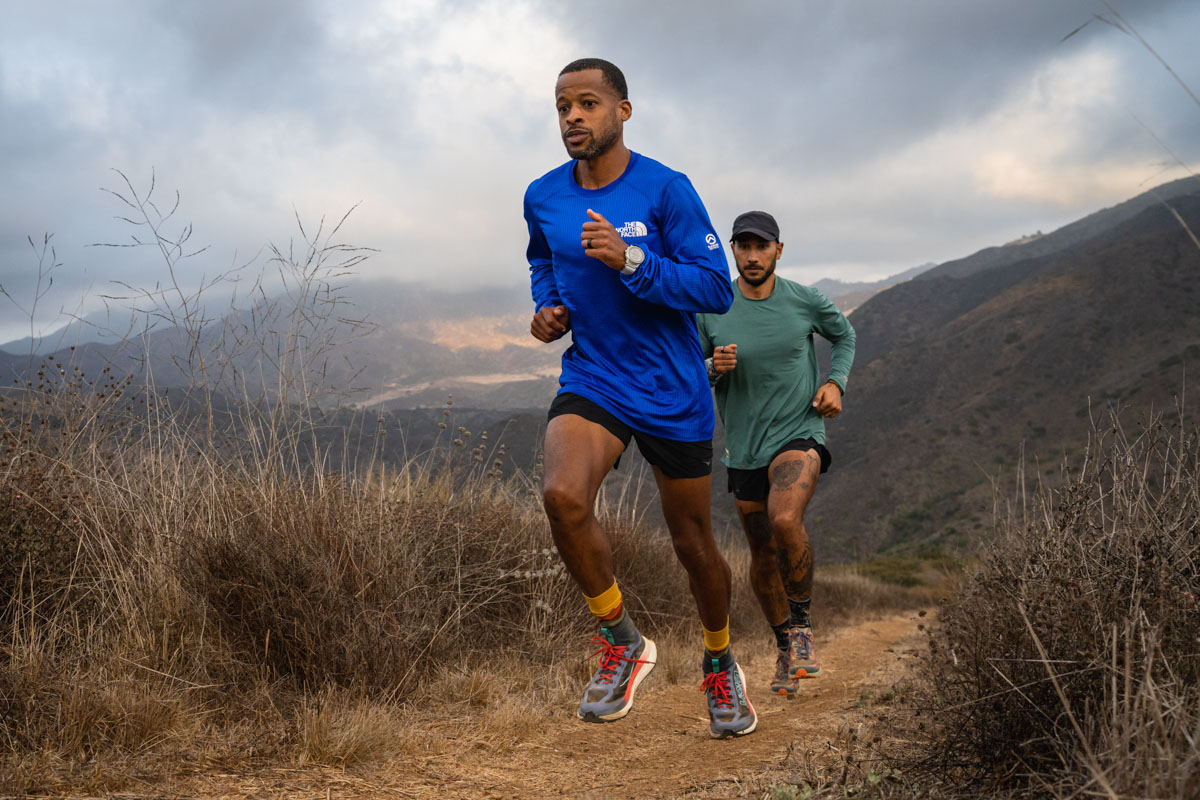
Tall crew socks can provide additional lower-leg protection on trails. Photo: iRunFar/Eszter Horanyi
Sock Height
The best running socks come in various sizes for different applications, from neighborhood sidewalks to rugged mountain ridges. No-show and extra-low cuts sit at and below the ankle, and a quarter-length sock rests above the ankle. A crew size hits beneath the calf, and an over-the-calf or knee-high sock reaches just below the knee.
Generally, a taller sock such as a quarter-length or crew-height, like the Stance Ultralight Performance Crew Socks or Lé Bent Zero Cushion 3/4 Crew Trail Sock, is desired for trail running and ultrarunning to cover and protect the ankle and lower leg from tall grass or brush, rocks, and anything else that can scratch you. Low-cut socks are great for runs on the track or road with no vegetation or when it’s really hot.
Some people love socks that disappear into the shoe. The lowest-cut sock we included in this guide is the Smartwool Run Ankle Socks, which still provide reasonable ankle protection. Again, this is ultimately a matter of personal preference.
On the opposite end of the spectrum from no-show socks are knee-high socks, which provide the most protection against the elements. Many trail runners opt for taller socks for the increased protection they provide, even though they inherently feel warmer than shorter socks. Tall socks can also feature graduated compression where they are tightest at the ankle and become gradually looser further up the leg. Most tall compression socks, including the CEP The Run Compression Tall Socks 4.0, provide 20 to 30 millimeters of mercury of compression. If you want to learn more about other options for compression socks, you can check out our full Best Compression Socks guide.
Our top-ranked socks are between knee-high and no-show. Our highest-rated, favorite socks for most of our runs from mountains to deserts are a range of crew heights that rise three to five inches above the ankle. We found that our favorite overall sock, the Swiftwick Flite XT Trail Mid-Crew, excelled in a variety of conditions.

Crew-length socks need to be able to stay up and not bunch around the ankle. Photo: iRunFar/Eszter Horanyi
Durability
The most durable running socks employ a blend of synthetic fibers, which helps the sock maintain its form and support. Synthetic fibers are more robust and stretchy and have a longer lifespan than natural fibers such as sheep or alpaca wool. This explains why every sock in our guide holds a percentage of synthetic material, even when mixed with natural fibers. A synthetic blend coupled with natural fibers, like that in the Darn Tough Stride Micro Crew Ultra-Lightweight Running Sock, is still a top choice for running socks because natural fibers provide specific qualities such as moisture transfer, breathability, odor resistance, or softness. We appreciate that Darn Tough will replace socks that develop holes in them.
Performance socks feature abrasion-resistant fibers in high-use areas of the foot that normally wear down, like beneath the toe, Achilles area, and heel.

Regardless of your style of sock, you want them to keep your feet free from blisters and hot spots. Photo: iRunFar/Eszter Horanyi
Why You Should Trust Us
We began this guide by polling the 20-plus-person iRunFar team with hundreds of years of running experience about their preferred running socks. We also researched dozens of the highest-ranked, most popular, and top-selling socks for runners. In doing so, we honed a list of running socks for regimented testing.
In the initial creation of this guide, six product testers covered hundreds of miles with the first round of socks. Since then, iRunFar’s team of regular gear testers and its buyers guide team members have been constantly testing running socks, and we periodically update this guide according to our testers’ feedback.
We tracked miles through various environments across the San Juan Mountains, Elk Mountains, and Front Range of Colorado, as well as mountains and deserts throughout Utah, Wyoming, Montana, and the scree-strewn slopes of Oregon’s Cascade volcanoes. We also took socks out in the notoriously rugged and wet conditions in the New Zealand backcountry. In addition to testing socks on shorter daily runs, we wore a number of the socks included in this guide during race and FKT efforts, including Western States, IMTUF, Hardrock 100, and Nolan’s 14.
We meticulously examined the socks throughout each run and ranked each sock on breathability, moisture transfer, cushioning, overall protection and comfort, and durability. A handful of socks scored high in many, but not all, traits, while others we tested didn’t make the cut.

iRunFar’s Meghan Hicks (right) tests a pair of Injinji socks on a fastpacking trip in New Zealand. Photo: iRunFar/Eszter Horanyi
Frequently Asked Questions About Running Socks
Should running socks be thick or thin?
The perfect amount of material in a running sock depends on personal preference, including a runner’s preferred footwear. Running shoes with a narrower toebox and more streamlined fit often pair best with lighter-weight socks like the Drymax Extra Protection Hot Weather Running 1/4 Crew Socks or the Stance Ultralight Performance Crew Socks. Also, some runners’ feet swell in hotter conditions or during long-distance runs, so thicker socks can become too cumbersome. That said, the added warmth from a slightly thicker sock like the Swiftwick Pursuit Quarter Crew High is ideal in cooler running conditions.
It’s important to ensure your sock fits well and is neither too tight nor too bunchy. “Socks that are chronically too tight can cause joint and myofascial tension in the foot,” says Joe Uhan, a physical therapist, coach, ultrarunner, and regular contributor to iRunFar through his Stay the Course column. Uhan recommends natural fiber socks like the Smartwool Run Ankle Socks and a fit that doesn’t take effort to pull on or bunch up and cause irritation.

Road running socks tend to be lower and provide less protection than their trail counterparts. Photo: iRunFar/Eszter Horanyi
How long do running socks last?
The lifespan of running socks depends on many factors, including the quality and type of materials woven into the sock and how a runner uses the socks. All fibers break down over time from sunlight, moisture, oils of human skin, friction inside our running shoes, contact with brush and rocks, and wash-and-dry cycles.
Socks made of synthetic fibers, such as the Drymax Extra Protection Hot Weather Running 1/4 Crew Socks, are generally more durable, stain-resistant, and longer-lasting than natural-fiber ones. The socks in this guide include entirely synthetic fibers or a natural and synthetic fiber blend, and none have lower-than-expected lifespans.
Additionally, following your socks’ laundering instructions can help them last longer. For instance, socks with terry loops will re-fluff when dried in a dryer, and their care instructions will note to tumble dry. Other socks, especially wool blends such as the Swiftwick Pursuit Quarter Crew High, which is 63% merino wool, shouldn’t be machine-dried because high heat affects the fiber integrity. The Feetures Elite Ultra Light Mini Crew above should be washed inside-out in cold water and hung up to dry. Also, using a harsh detergent can decrease a sock’s perceived functionality, as the detergent’s residue can reduce the sock’s breathability.
Wearing the proper size socks and trimming your toenails can also help reduce wear. Walking around inside or outside in socks without shoes on can also deteriorate the fabric. While we are elated when our run socks last two or three seasons, we’re not surprised if they’re barreled after one.

No-show socks are an excellent option for hot days when you want to stay as cool as possible. Photo: iRunFar/Eszter Horanyi
Should I wear compression socks for running and recovery?
Between runs, compression socks like the CEP The Run Compression Tall Socks 4.0 can support blood circulation in a runner’s legs, which helps prevent and reduce swelling. Some evidence from the Cleveland Clinic, a premier academic medical center based in Cleveland, Ohio, also shows that compression socks worn during a run can positively impact performance on the athlete’s next run and aid recovery. Tall socks can also help protect the lower leg and ankles from shrubs, sunshine, rain, snow, or harsh wind.
Most importantly, if compression socks make you feel good during a race or on a run, adding them to your kit is likely a good idea. Compression socks should fit your feet and calves snugly but not feel too tight. You can learn more about this style of sock in our Best Compression Socks guide.
Again, physical therapist Uhan recommends wearing compression socks as needed and not spending too much time in very tight socks. He says, “Some compression, used intermittently and at times of acute/subacute injury, is useful, but constant compression will limit tissue (and fluid) mobility of all kinds. Key fascial layers that extend from feet upward to the trunk can get too tight and stiff with prolonged compression use.”

Alli Miles of iRunFar tests a pair of ankle socks during a morning road run. Photo: iRunFar/Eszter Horanyi
Compression socks feature a range of tightness levels from eight millimeters of mercury (mmHg) to 50 mmHg. Silhouettes made for runners, including the CEP The Run Compression Tall Socks 4.0, typically offer 20 to 30 mmHg. Such socks also generally feature graduated compression, meaning they are tightest at the ankle and become gradually looser further up the leg.
If you’re curious about compression socks, we recommend talking with your physical therapist or healthcare provider before investing. According to the Oklahoma Heart Institute, some people with diabetes can experience complications while using compression socks.
Should I wear special socks for cold and hot weather?
For the most part, it’s a matter of simple comfort. When you run in hot weather, it’s best to pull on your most breathable, moisture-wicking socks. When you run in cold weather, thicker socks that are still fairly breathable and moisture-wicking will be ideal. If precipitation occurs, choosing a pair that retains heat even when wet, such as socks with a natural fiber blend, like wool or alpaca, is a good idea.
We chose the Darn Tough Stride Micro Crew Ultra-Lightweight Running Sock as our favorite wool-blend sock, and we were also impressed by the ability of the Lé Bent Zero Cushion 3/4 Crew Trail Sock to keep us cool when things got hot and warm when temperatures dipped.
A taller sock height is a good choice for cold weather. In hot weather, shorter socks are generally more comfortable, though choosing a sock cuff that’s so short it doesn’t stay fixed against the ankle can lead to the sock sliding down and bunching. Shorter socks also don’t protect against vegetation or rocks. Our favorite socks for cold weather are the Swiftwick Pursuit Quarter Crew High, and we love the Drymax Extra Protection Hot Weather Running 1/4 Crew Socks in warmer seasons.
Can socks help prevent blisters?
Friction while running — when a part of the foot rubs against another part of the foot or the socks and shoes you’re wearing — can cause blisters for a runner. Some runners experience blisters on their heels, while others find the painful nuisance on their toes or even the soles of their feet. Choosing socks and shoes that fit well — and fit well together — is important to prevent hot spots that become blisters.
If the hosiery has too much material or is too loose, the fabric can slip or shift, and repeated shifting and rubbing can cause a hotspot that develops into a blister. The snug fit and slight compression of the Swiftwick Flite XT Trail Mid-Crew can keep feet free from blisters by minimizing rubbing.
The sock fibers can make a difference, too. One of our sock testers experienced blisters directly under her forefeet caused by her socks during downhill sprints that day. They feature nylon (75%) and elastane (13%), and the bottom of the sock was too slick for the specific mechanics of the workout.
The best way to prevent horrible blisters is to take your socks out for a variety of shorter runs, from speedy sprints on flat paths to steep climbs and downhills, to ensure your feet and footwear operate well with that sock. And if you begin to experience hot spots or blisters, stop and address them immediately.
If you frequently get blisters between your toes, you might want to consider using a pair of toe socks, like the Injinji Run Lightweight Crew. Having material between our toes can keep them from rubbing together and creating hot spots. For some people, compression socks, like the CEP The Run Compression Tall Socks 4.0, that fit more snugly around the foot, reduce the chance of rubbing and blisters.

While no-show socks don’t provide much lower-leg protection in rough conditions, some mountain runners still prefer them. Photo: iRunFar/Eszter Horanyi
Morgan Wolf, Product Manager at Swiftwick, suggests finding socks that fit well and incorporate materials that work well for your feet. “For all runs, runners should look for moisture-wicking, well-fitted socks to prevent blisters, which are often caused by the combination of friction, pressure, and moisture. Socks, like shoes, are sized to your foot, and having an improper fit may lead to blisters, so make sure that the socks you choose are not too tight or too loose,” Wolf explains. “In addition, look for breathable, moisture-wicking fibers, such as olefin, which moves moisture away from your skin, greatly reducing the likelihood of chafing and overheating your feet.”
Finally, after choosing their favorite footwear and socks, some runners also apply powder lubricant to the inside of their socks or a gel lubricant like Body Glide or Squirrel’s Nut Butter to their feet before running. Dehydration and electrolyte imbalances may also contribute to blisters.
Read our in-depth article on blister care and prevention to learn more.
What’s the deal with toe socks?
Toe socks, where each of your toes gets its own little covering, have become increasingly popular in ultrarunning in recent years. Toe socks can help prevent blisters between the toes by putting a layer of fabric between them. The extra fabric also causes the toes to splay a bit more, which can increase toe engagement throughout the stride.
The Injinji Run Lightweight Crew socks are the best toe socks we’ve tested. Toe socks generally don’t work well for people with shorter- or longer-than-normal toes, as they either have excess material that causes bunching or create a web-footed situation. Most people wear toe socks as a standalone sock, though some people will double up on socks by putting a normal sock over a toe sock.

Toe socks can help reduce blister-causing friction between the toes, and Injinji toe socks are especially popular among runners.
Call for Comments
Is there a pair of excellent running socks that has improved your runs? Share it in the comments below so we can consider it for future updates to this guide.
